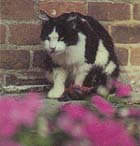Protection from Predators
Cats

Nesting birds are extremely vulnerable to cats, as are fledglings and birds roosting for the night. Bell collars on cats offer birds little protection. Nailing a sheet metal guard or cone to a tree trunk is unsightly, but may deter less agile felines. Houses mounted on metal poles are the most difficult for predators to reach, especially if you smear the poles with petroleum jelly and hot pepper mixture. The best deterrent is for owners to keep their cats inside whenever possible.
Dogs
Pet dogs are a hazard to nestlings in the spring and summer. Don’t let your dog run loose during nesting time.
Squirrels
Red squirrels, and sometimes gray squirrels, can become a serious menace to bird houses and the birds themselves. If you find your riest hole enlarged, chances are a red squirrel is the culprit. Once inside the box, squirrels make a meal of the eggs and young. Adding a predator guard made of sheet metal to the entrance hole is usually enough to keep squirrels out.
Raccoons and Opossums
Raccoons and opossums will stick their arms inside nest boxes and try to pull out the adult, young, and eggs. Adding a ‘/.,-inch thick predator guard to the birdhouse or an inverted cone to its pole support is a simple solution.
Snakes
Snakes play an important part in the balance of nature. If you find one in your birdhouse, don’t kill it. Snake-proof your house by putting it on a metal pole lathered with petroleum jelly or red cayenne pepper.
House Sparrows and Starlings
If you don’t discourage them, these two nuisance species introduced from Europe will harass or kill cavity-nesting birds. Since house sparrows and starlings are not protected by law, you may destroy their nests. But remember, other birds are protected by law.
House Wrens
House wrens sometimes interfere with the nesting success of other birds by puncturing their eggs. But, unlike the house sparrow and starling, these birds are native to North America and are protected by law. Don’t be tempted to intervene when wrens appear at your backyard birdhouse.
Insects
Many insects lay their eggs and pupate in birdhouses. Inspect your birdhouses for signs of gypsy moths, blow flies, wasps, ants, gnats, and bees. Keep bees and wasps from attaching their nests by coating the inside of the roof with bar soap. In areas where gypsy moths abound, avoid placing boxes in oak trees, which the gypsy moths favor.
Pyrethrin and rotenone insecticides are recommended for killing fly larvae, bird lice and mites after birds have finished nesting for the season.
Other Links:
- For the birds
- Back yard bird feeding
- Bird Feeder Selection
- How Many Birds
- Birds Attracted by Various Feeders and Foods
- Uninvited Guests at the Birdfeeder
- Questions about Feeding Wild Birds
- Homes for Birds
- Selecting a Bird House
- Bird House Design
- Bird Nest Box Dimensions
- Bird House Placement
- Protection from Predators
- Attracting Birds
- Landscaping for Birds
- Basics of Landscaping for Birds
- Plants for Wild Birds
- How to Get Started
- Protecting Bird Habitat
- Additional Readings
